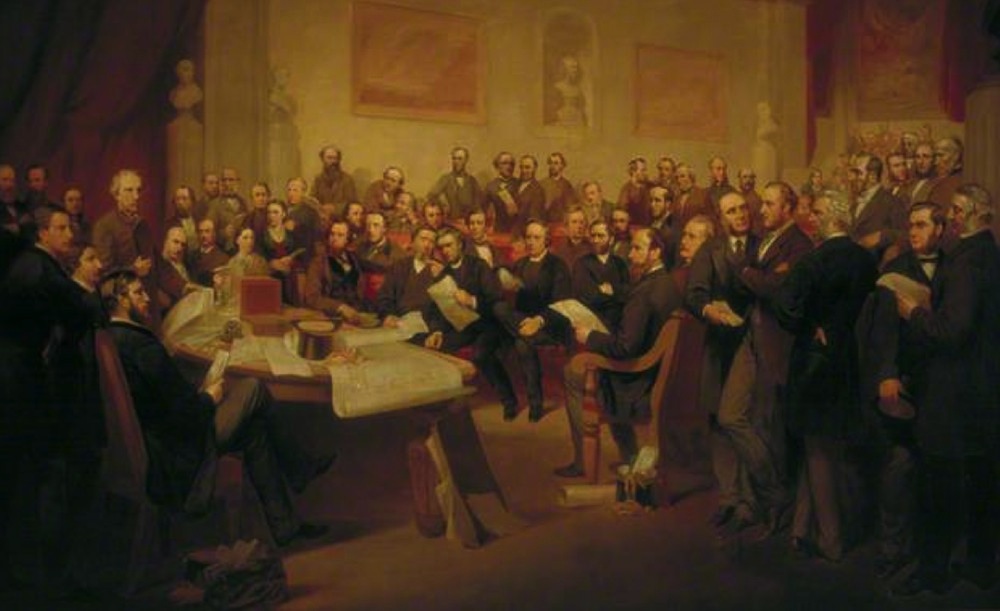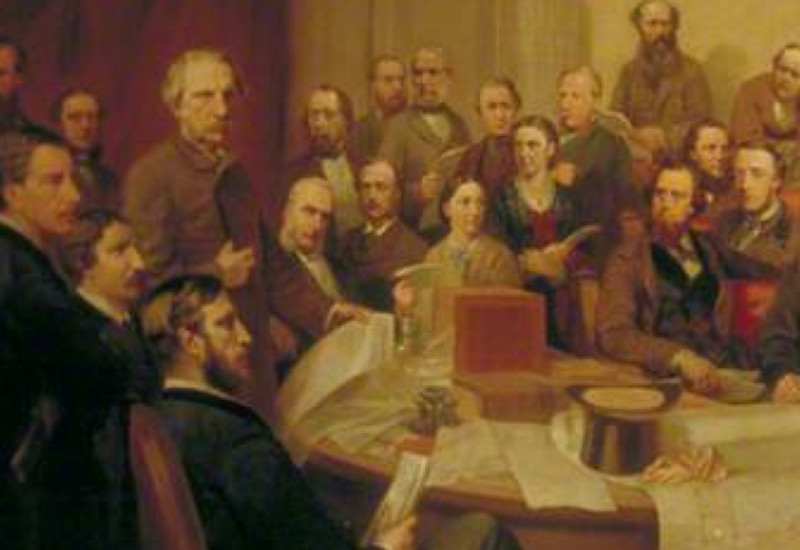
The First London School Board by John Whitehead Walton (1815-95). c.1873. 136 x 215 cm. Oil on canvas. Collection: Guildhall Art Gallery, London. Reproduced courtesy of the City of London Corporation. Commentary by Jacqueline Banerjee. [Click on all the images here to enlarge them.]
This painting, transferred to the Guildhall Art Gallery from the Inner London Education Authority in 1990, is much more interesting than at first appears. It depicts a board meeting, with people sitting and standing more or less in a semi-circle facing a heavy table covered with papers and plans. Here an elderly man is standing on the upper left, paper in hand, apparently listening to a discussion taking place among the board members on the other side of the room. The three men seated lower down the table are looking in this direction too. It is all done in a naturalistic and varied way: the members, including two clergymen in the middle, one of whom is listening to his neighbour on the other side, must be individually identifiable, in the manner of such official portraits of proceedings.
For those studying the history of education in Victorian times, the painting is especially interesting. It relates to an important milestone in the progress of free compulsory elementary schooling for all: the work of the first School Board for the metropolis (which was split into ten divisions) as established under the Public Elementary Education Act of 1870. The speaker standing at the table, with what looks like a file in one hand and a paper in the other, is quite unmistakably the elderly chairman of the board, Lord Lawrence, the ex-Viceroy and Governor-General of India (1811-79), who on his return from the East was appointed as its first chairman. The appointment had been controversial: there were fears that he might "govern despotically" (see "The Chairman of the Board"); but he had promoted education in India, and is shown to be listening to what others have to say here. He held this office in London from 1870-73. It is tempting to guess that the bearded man sitting with his legs crossed on the left is the science educationalist T.H. Huxley, still in his 40s then. But that is much less certain.


Details of the painting. Left: A closer view of Lord Lawrence, with two women a little further to the right. Right: A closer view of the women, taken on a later visit, on a sunnier day. The one who is seated looks like Emily Davies, and the one who is standing looks like Elizabeth Garrett Anderson, but again it is hard to be sure.
Two members, however, are easy to identify, if not individually, at least as a pair. Most visitors to the Guildhall Art Gallery may not notice, but the Board is not entirely male in composition. Two women are present, close to Lord Lawrence but more towards the centre. One would have been the pioneering physician, Elizabeth Garrett Anderson, who won a landslide victory for a seat in the Marylebone division. She was first woman in the country to hold this kind of position: Robert Browning himself had helped to campaign for her:
In November 1870 she was a candidate for the London School Board; the husbands of her patients in Marylebone formed themselves into committees to support her candidature, with the result that her name appeared at the head of the poll with 47,000 votes, the highest vote, it is said, ever recorded in these elections; the poet Browning was among her enthusiastic supporters. [F. C. Johnson]
Also voted in was Anderson's friend Emily Davies: she was elected for Greenwich (see Murphy and Raftery ix). The fact that all rate-payers, whether male or female, could vote in its elections (a rule that undoubtedly facilitated the two women's election), made the Board "the first of the Metropolitan authorities to be directly elected on a democratic basis" ("School Board for London"). How hard it must have been for these pioneering women to take their places in these otherwise all-male enclaves.
In its role of providing school premises for children, the London School Board had already (in 1871) appointed the architect E. R. Robson, and he built or supervised the building of hundreds of London schools, such as that in Primrose Hill. The School Board was closed in 1903 when its role was taken over by the London County Council.
Sources
"The Chairman of the London School Board." Times. 19 December 1870: 12. Times Digital Archive. Web. 3 February 2015.
Johnson, F. C. "Anderson, Elizabeth Garrett (1836-1917)." In the DNB archive at the current entry for Anderson. Oxford Dictionary of National Biography. Online edition. Web. 3 February 2015.
Murphy, Ann B., and Deirdre Raftery, eds. Chronology. Emily Davies: Collected Letters, 1861-1875. Charlottesville: University of Virginia Press, 2004. ix-xii.
"School Board for London AIM25 (Archives in London and the M25 area). Web. 3 February 2015.
Steele, David. "Lawrence, John Laird Mair, first Baron Lawrence (1811–1879)." Oxford Dictionary of National Biography. Online edition. Web. 3 February 2015.
Last modified (extra image added) 19 May 2018